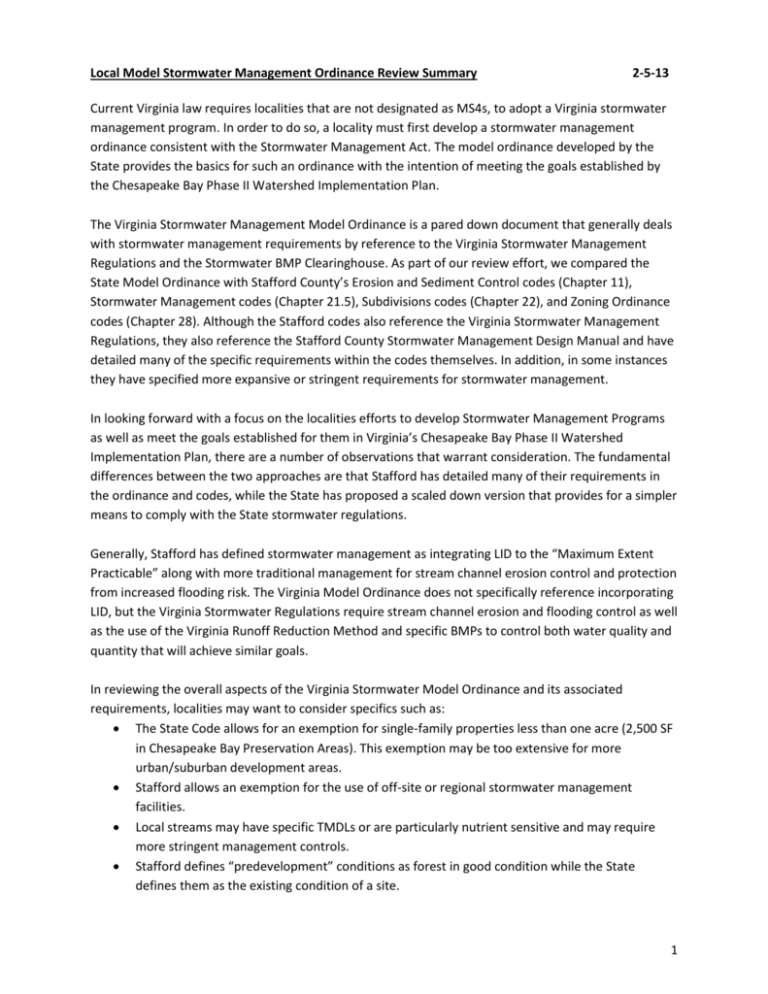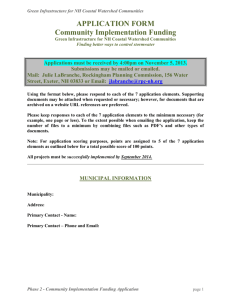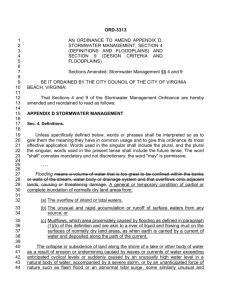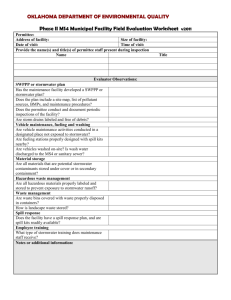Local Model Stormwat..
advertisement

Local Model Stormwater Management Ordinance Review Summary 2-5-13 Current Virginia law requires localities that are not designated as MS4s, to adopt a Virginia stormwater management program. In order to do so, a locality must first develop a stormwater management ordinance consistent with the Stormwater Management Act. The model ordinance developed by the State provides the basics for such an ordinance with the intention of meeting the goals established by the Chesapeake Bay Phase II Watershed Implementation Plan. The Virginia Stormwater Management Model Ordinance is a pared down document that generally deals with stormwater management requirements by reference to the Virginia Stormwater Management Regulations and the Stormwater BMP Clearinghouse. As part of our review effort, we compared the State Model Ordinance with Stafford County’s Erosion and Sediment Control codes (Chapter 11), Stormwater Management codes (Chapter 21.5), Subdivisions codes (Chapter 22), and Zoning Ordinance codes (Chapter 28). Although the Stafford codes also reference the Virginia Stormwater Management Regulations, they also reference the Stafford County Stormwater Management Design Manual and have detailed many of the specific requirements within the codes themselves. In addition, in some instances they have specified more expansive or stringent requirements for stormwater management. In looking forward with a focus on the localities efforts to develop Stormwater Management Programs as well as meet the goals established for them in Virginia’s Chesapeake Bay Phase II Watershed Implementation Plan, there are a number of observations that warrant consideration. The fundamental differences between the two approaches are that Stafford has detailed many of their requirements in the ordinance and codes, while the State has proposed a scaled down version that provides for a simpler means to comply with the State stormwater regulations. Generally, Stafford has defined stormwater management as integrating LID to the “Maximum Extent Practicable” along with more traditional management for stream channel erosion control and protection from increased flooding risk. The Virginia Model Ordinance does not specifically reference incorporating LID, but the Virginia Stormwater Regulations require stream channel erosion and flooding control as well as the use of the Virginia Runoff Reduction Method and specific BMPs to control both water quality and quantity that will achieve similar goals. In reviewing the overall aspects of the Virginia Stormwater Model Ordinance and its associated requirements, localities may want to consider specifics such as: The State Code allows for an exemption for single-family properties less than one acre (2,500 SF in Chesapeake Bay Preservation Areas). This exemption may be too extensive for more urban/suburban development areas. Stafford allows an exemption for the use of off-site or regional stormwater management facilities. Local streams may have specific TMDLs or are particularly nutrient sensitive and may require more stringent management controls. Stafford defines “predevelopment” conditions as forest in good condition while the State defines them as the existing condition of a site. 1 Local Model Stormwater Management Ordinance Review Summary 2-5-13 Stafford requires the use of LID on redevelopment projects and specifies a desired pollutant load improvement factor of 10%. The State requires either a 10% or 20% reduction in phosphorous discharge. The State Stormwater Regulations and BMP Clearinghouse list the approved BMPs that can be used to meet the water quality and quantity requirements. Stafford (and other counties) generally recognize additional BMPs that are not currently on the “approved” list. The ultimate use of BMPs should be based on recognized pollutant removal efficiencies. Stafford recognizes the need to encourage the preservation of pervious soils by placing infrastructure and impervious areas such as houses, roads, and buildings on more impermeable soils (Hydrologic Soil Groups C and D). The State makes no such recommendations. Stafford details that management plans and BMP inspections be developed and conducted by licensed professionals. Stafford requires a performance guarantee while the Model Ordinance makes no such stipulation. Stafford details specific stormwater management requirements for certain types of zoning districts. The State Model Ordinance makes no reference to any specific types of development. KEY PROVISIONS OF THE MODEL ORDINANCE: Water Quality o Total Phosphorus still used as benchmark pollutant o Runoff Reduction Method o New Development o Redevelopment o Offset Provisions o Virginia BMP Clearinghouse (All based on pollutant removal efficiencies and the list seems entirely exclusive at this juncture – many locally utilized BMPs not included) Water Quality Offsets o Old rules – local governments were authorized to allow nutrient offsets under certain circumstances. o New rules – developers are allowed to use offsets under described conditions: Under five acres disturbed; Less than 10 lbs reduction required; or Onsite control of at least 75 percent of the required nutrient reductions. o Offsets are not allowed for water quantity. (Potential legislative initiative?) Water Quantity Requirements o Channel Protection Protection criteria are now situational – manmade, modified, and natural channels. o Flood Protection Also situational – existing localized flooding vs. no existing localized flooding. Not well defined for natural channels. Less stringent than current County requirements. o Increased Sheet Flow 2 Local Model Stormwater Management Ordinance Review Summary o o 2-5-13 Must be evaluated – can’t adversely impact downstream property, cause erosion, sedimentation, or flooding. The same as current County requirements. Grandfathering Use current stormwater technical criteria: Plans approved before July 2012 and obtaining a VSMP permit before July 1, 2014. Includes: Proffered or conditional zoning plans Preliminary or final subdivision plats Preliminary or final site plans Zonings with a plan of development Grandfathering ends June 30, 2019 or termination of permit. Stormwater Pollution Prevention Plans (are not currently required by Stafford) 3






